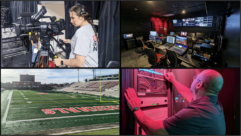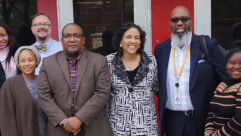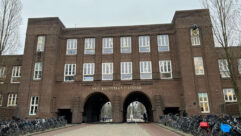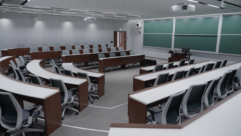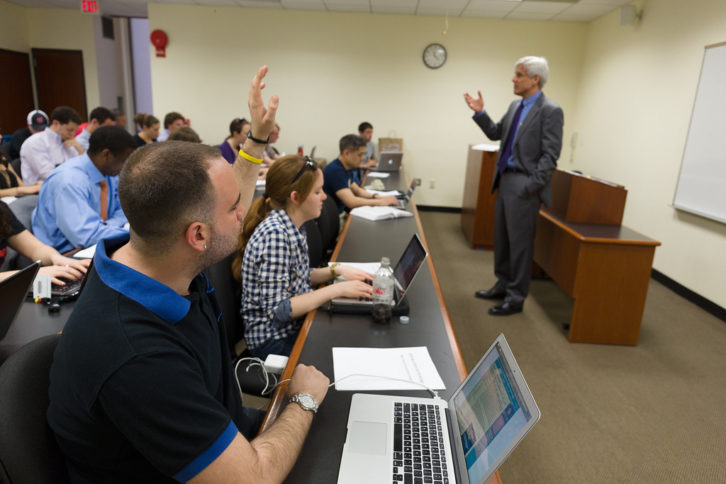
At George Washington University Law School they’re no strangers to video technology and they knew they needed an upgrade for better video recording and conferencing. Head of Instructional Technology, Matt Bochniak is going to tell us how Cattura streaming and Vaddio cameras brought the 55 classrooms up to speed and supported the school’s extensive roster of remote guest speakers.
SVC: Hi Matt, first tell us a bit about George Washington University Law School.
Matt Bochniak: We roughly have 2,000 students, approximately 55 classrooms across seven buildings here. We’re located right in downtown Washington D.C. We’re just a couple blocks from the White House.
You’ve been working on a big technology upgrade there with increased video and recording capability. Is there a unique challenge or benefit that’s specific to law classes when implementing video technology?
I would like to start by saying we value our students’ learning experience and we want to provide the law school community with the best technology possible to achieve our learning outcomes for our students. We had an older video recording system that we felt wasn’t flexible for our changing needs. So about five years ago we began a remodeling process of our classroom technology. In that process, we really wanted to address two major points. We wanted to put a video recording system in that allows us to publish through multiple channels, and we wanted to incorporate web conferencing technology. It’s important to have the ability to have a wall-less environment especially where we are in D.C. We wanted to be able to bring experts easily into any of our classrooms.
A big part of doing that is making sure that it’s implemented smoothly so your professors aren’t fooling with the technology all the time.
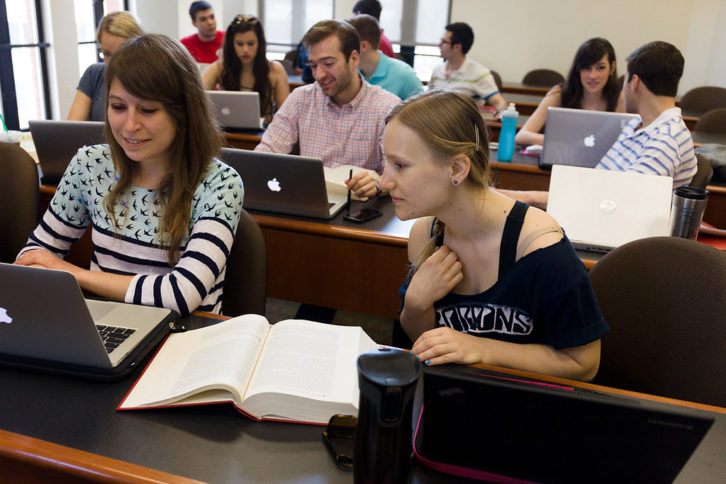
Absolutely. Transparent technology is definitely important. Our classrooms are full of technology, but it’s transparent to both the students and faculty members and the people using the rooms. We have 55 rooms. They all are classrooms, but they also serve as meeting spaces. They also serve as event spaces. They also serve as places where faculty will interview other candidates. They serve various needs and have the same technology in every single classroom. And having the ability to service and support that was also important.
Let’s talk about the video streaming and recording part of this. I think you implemented the Cattura Kaltura platform for this. Why was that particular one chosen?
Mainly for open formats. I sat down with Mike Briggs, our IT director here at the law schools, and we both agreed that having an open format solution was key. So it ties to how we use the room, right? If we’re doing an academic recording, it has to be permissioned in such a way that only one student can watch that recording. Our academic recording policy is very strict. We have to be able to track and maintain who’s watching what videos so if a student has an approved recording made for them, even though there might be 100 students in that class, only one student will have access to that recording. We had to handle that requirement, but we also have to support other use cases. On any given day, we host an average of five events here in our rooms and most of those events are being recorded. We had to have a place for those recordings to live. On our old system, we were hosting them in our servers. Recordings were just getting bigger and bigger and more and more costly. Now if it’s an event recording we’re probably going to stream it to YouTube; we’re no longer maintaining this huge catalog of recordings. That was important to us. If we’re streaming live it might be on the law school’s Facebook page. But if it’s an academic recording it’s going into our Kaltura system, which is really locked down, to achieve the goals of our academic recording policies.
Well, with people watching different videos in 55 different rooms that’s a lot to keep up with.
Yes. It’s a very large operation here that I run alongside Andrew Lawrence, who is our media technology coordinator, and about nine student employees.
Who actually handled the initial installation and testing for this?
We tackled this in different phases. The remodel phase was over a four-year period. In the remodel phase, we had some rooms that were on an old analog AMX switch and we had some rooms going to an AMX digital switcher. So we started with that part, getting all of our analog gear into the AMX digital world. And then at that point I started looking at the conferencing aspect of it and we started incorporating the Vaddio AV Bridges into the designs in those early years. Once we were done with that, we then looked into upgrading the video system and retiring our older system and moving to this Cattura-Kaltura/open format system that we are currently using. You know, we only had two months to decommission and reinstall and commission a brand-new recording system. That was done pretty much hand-in-hand with Cattura. They did a lot of work with us. And then Acuity did the remodel and they were also onsite when we did the Cattura installations and decommissions of our older video recording system.
How exactly is the videoconferencing used in the classroom now?
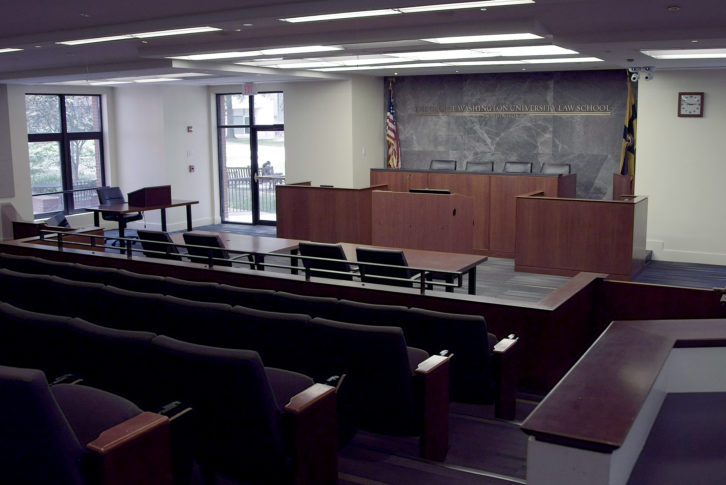 We have a group of faculty that will bring expert guests into the classroom. Most of the time it’s other attorneys, but they might bring other important people that can’t make it physically into the classroom at like, say, 6:00 p.m. on a Thursday. The other aspect that we’re using—the web conferencing—is for our growing online LLM program. With our LLM program, our faculty will have office hours via Blackboard Collaborate. Oftentimes they’re teaching here during the day and they just stay and just go into a classroom at night and do their office hours through Blackboard Collaborate through our AV system. They’re also bringing in guests into those office hours, so that’s another aspect of how the web conferencing technology of our system is being used in learning.
We have a group of faculty that will bring expert guests into the classroom. Most of the time it’s other attorneys, but they might bring other important people that can’t make it physically into the classroom at like, say, 6:00 p.m. on a Thursday. The other aspect that we’re using—the web conferencing—is for our growing online LLM program. With our LLM program, our faculty will have office hours via Blackboard Collaborate. Oftentimes they’re teaching here during the day and they just stay and just go into a classroom at night and do their office hours through Blackboard Collaborate through our AV system. They’re also bringing in guests into those office hours, so that’s another aspect of how the web conferencing technology of our system is being used in learning.
What are the various videoconferencing applications that can interface with your system? I know they can use a wide variety of them.
Yes. Pretty much all of them can. The GW users will generally use Webex, Google Hangouts Meet or Blackboard Collaborate. We use all three of them constantly here in the law school. However, when outside people use our space to do meetings not tied officially to the law school, they might use Skype or Zoom.
How did the hardware installation go? Did you need new wiring and camera mounts?
Absolutely. The four-year remodeling process was pretty much a full gut job. We took out old standard definition cameras and video equipment and replaced it with HD cameras and video equipment, so it was a lot. New wall mounts. Half of our racks were pretty much gutted during the remodel. We couldn’t keep that much.
Did you have to run new wiring in each of the classrooms?
Yes. We ran new wiring to the classrooms and we also invested in fiber so we have fiber jumps from closets to closets that go back to our central control – our master control.
Where is all the support equipment mounted? Obviously, you have to have that in a secure place.
Normally all of our classrooms, except for a few, have a closet attached to them. It’s just a door in a corner of the room. If you open that door, there is a wall of racked equipment. That all gets networked back to our master control, which is in our Office of Instructional Technology— that’s pretty much the brains of the whole operation. We have room control of all 55 classrooms from one room. We also have a closed-circuit phone system to all the 55 rooms. There’s a white phone that we train our faculty on that’s right by the podium – it automatically rings and we know what room it’s ringing in the master control. And then we can pop up the room control for that room and actually nine times out of ten solve their problem. A lot of times it’s questions like ‘how do I get my laptop to project on the projector?’ We can just push a button at our master control without sending somebody down there. We keep the operation going until 10:00 at night during the weekdays and until 8:00 at night on the weekends. So anytime a faculty member has a problem, they just pick up the phone and they’re talking to a human being that can pretty much resolve their problem remotely.
Having the ability to do a lot of things by remote control really saves a ton on lost instruction time.
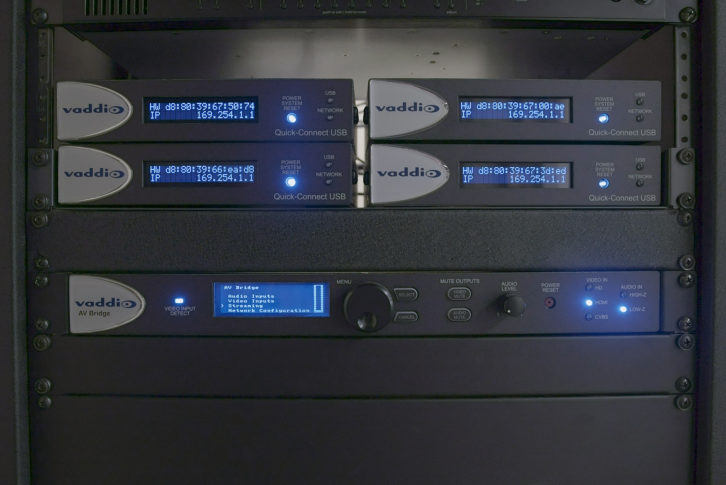 That’s a very important key to the design of our classrooms. We don’t want our 55 minutes of class time taken up waiting for a computer to boot or figuring out how to show a Power Point. We want to maximize the student experience and the faculty’s time with the students. It goes back to the whole transparent technology.
That’s a very important key to the design of our classrooms. We don’t want our 55 minutes of class time taken up waiting for a computer to boot or figuring out how to show a Power Point. We want to maximize the student experience and the faculty’s time with the students. It goes back to the whole transparent technology.
I noticed you use the Vaddio RoboSHOT cameras. Those have been around and they’re pretty much proven so why was that model chosen for this? Features or cost?
[Laughs] You just pretty much answered my question for me; they’re proven technology. I used them prior to coming down to GW with great success, so when I had the chance to put an HD camera into our classrooms, that’s just an easy one to use. It’s great. They work well. They give us good quality HD video. We never have to worry about rebooting them. That’s why I put them in their classrooms.
You also put in the Vaddio AV Bridges so how do those work and how are they installed? They sound pretty simple.
I love the AV Bridge. That’s probably my favorite aspect of our design. I think that this is something that a lot of people are missing the boat on—how simple this is. Basically you just feed your wall camera video and your room audio to it; it has a USB port and you plug the USB port into the back of your computer and your AV system. Now your computer sees it as a webcam. That’s as simple as it gets. We live in an age where web conferencing is the norm now and being able to do this in a classroom environment is just key, I think. I think it’s very important for institutions to understand the importance of being able to incorporate a guest lecture from anywhere in the world that can connect to Webex. I think it’s key to make a wall-less environment for our students, faculty and staff.
How is the sound picked up from the participants?
In pretty much all of our classrooms, we have a Biamp DSP audio audiomixer. And we have microphones all over the place and we have them set to certain thresholds. So once they get to a voice threshold they’ll turn off and turn on. That’s how we get the crowd or student audio to be picked up for classes. As far as the podiums, they all have mics on them. We also have wireless lav packs that we’ll give to faculty. In some of our rooms we have handheld mics. Some of our rooms we have the ability to put a tabletop microphone system in, which again works with our speaker systems and our Biamp system for audio.
Yeah, I would think the hand-held is best for gain before feedback if you have any kind of tough situation in there.
It’s always a challenge. I mean, we probably tune the system once every year, all of the rooms. As time goes on and microphone tolerances change it’s something that’s an ongoing thing, tuning the rooms for sound.
How did people take to it?
Professors and some of our more technology-forward faculty members took it on quickly. However, I think even more people will use it for our event spaces. I think our administrative staff will use it for meetings and for events that we host. One of the great examples of event spaces being used with this technology is going to be for our communications department. We do a Supreme Court briefing that we stream to the law school’s Facebook Live account. In that presentation we have some of our faculty members go over all the cases that the Supreme Court are going to be looking at for this session. We’ve had huge views for that and that was just using the AV Bridge to stream to Facebook Live. Very simple. It took us no time at all to set this up and it went without a glitch for two hours. So events people are the ones who have taken quickly to the technology.
What proved to be the most challenging part of it?
I think the most difficult part was over the four-year period being on two systems; being on an analog AMX and being on a digital AMX and keeping track of which room is working on which system. The other challenge would be the decommissioning and commissioning a new video system in two months. That was a lot of pressure for us to do that. As soon as the summer semester was over we had a two-month window, really, to decommission and put in place a new video recording system. Our racks are pretty full so we couldn’t have both of them sitting in the same rack, so we were challenged on that. It’s not like we could come in here six months earlier and start putting together the new system. We just didn’t have the rack space to do it. So we literally did this in a two-month process and it went well. We focused, we were detailed, and we were always on top of things and making sure that if we saw something wrong we fixed it immediately and we didn’t let anything sit.
Are there any future upgrades in the early planning right now?
Probably projectors is my next major task. I’m probably going to look into the laser projectors in our classrooms. Right now we’re still using the bulb kind. I think that’s the next big upgrade for our AV system.


